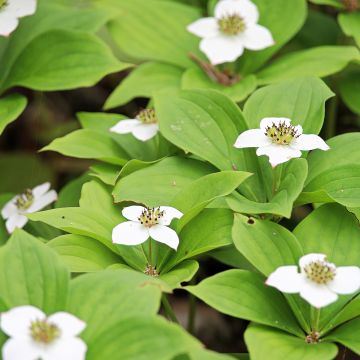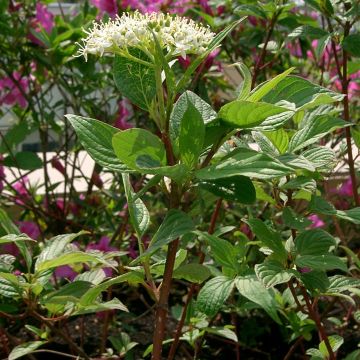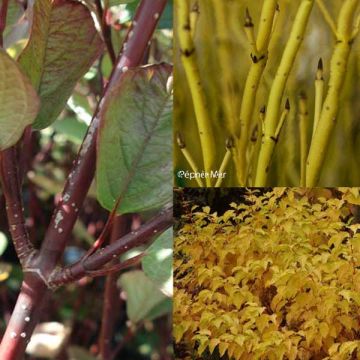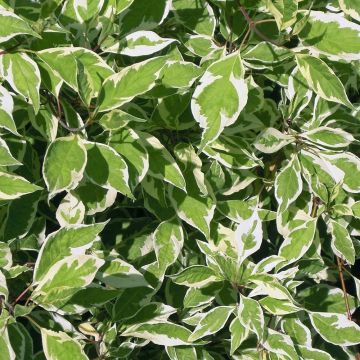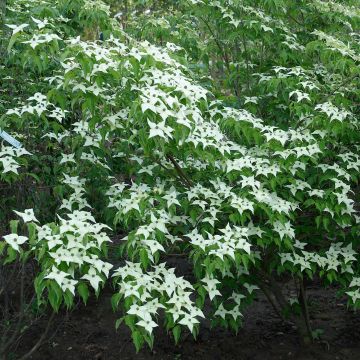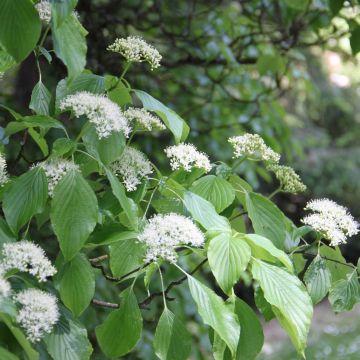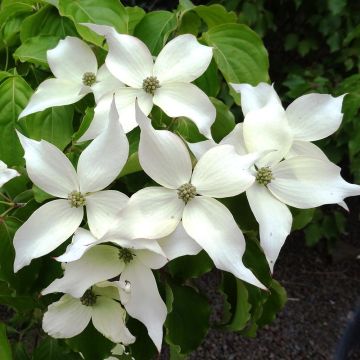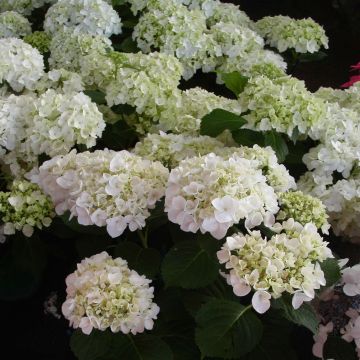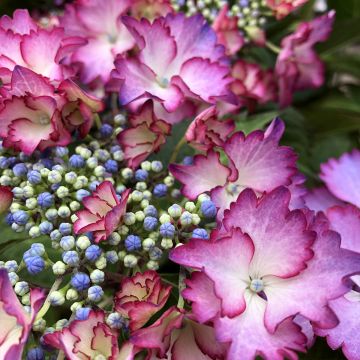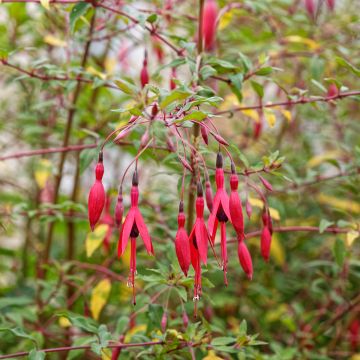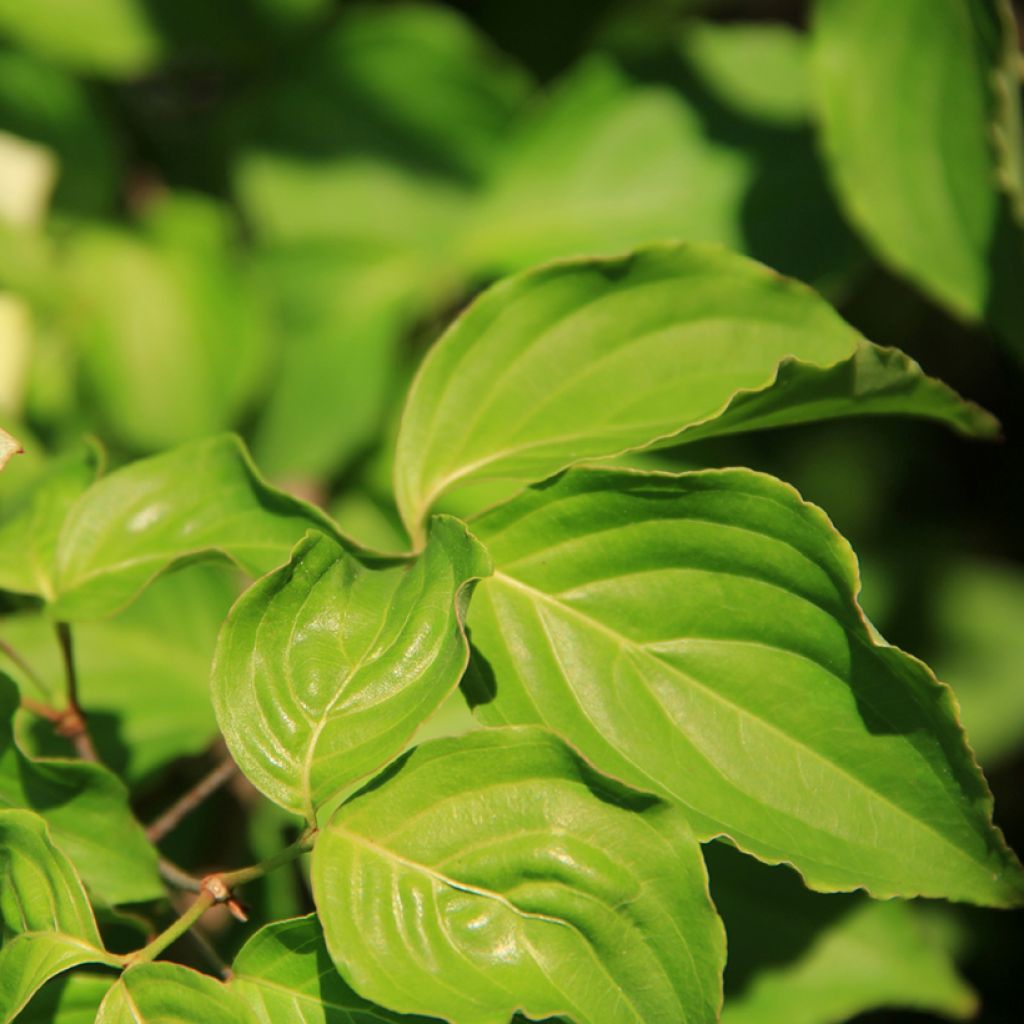

Cornus controversa Troja Dwarf - Giant Dogwood


Cornus controversa Troja Dwarf - Giant Dogwood
Cornus controversa Troja Dwarf - Giant Dogwood
Cornus controversa Troja Dwarf
Giant Dogwood, Wedding Cake Tree
Why not try an alternative variety in stock?
View all →This plant carries a 24 months recovery warranty
More information
We guarantee the quality of our plants for a full growing cycle, and will replace at our expense any plant that fails to recover under normal climatic and planting conditions.
From €5.90 for pickup delivery and €6.90 for home delivery
Express home delivery from €8.90.
Does this plant fit my garden?
Set up your Plantfit profile →
Description
The Cornus controversa Troja Dwarf is a dwarf form of the Pagoda Dogwood. This low-growing shrub, wider than it is tall, is well-suited for planting in small gardens. Its low silhouette is adorned with beautiful dark green foliage, which serves as a backdrop for the creamy white spring flowering. The small flowers, grouped in inflorescences about ten centimetres in diameter, bloom in June and later produce small blue-black fruits, which are relatively decorative in late summer. In autumn, the foliage takes on lovely purple colours before falling. An uncommon shrub, it can be integrated into a sunny or partially shaded flower bed, in moist soil that is non-calcareous or only slightly so.
The Dogwood belongs to the small family of Cornaceae, which, after several revisions of botanical classification, now only includes the genera Cornus and Alangium. There are several dozen species of Dogwoods, most of which are shrubs. However, in its natural habitat, Cornus controversa, native to China, Korea, and Japan, forms a tree that can reach up to 12 metres in height. It has a straight trunk and horizontal layers of vegetation, and it is the only species - along with C. alternifolia - to have alternate leaves, rather than opposite leaves. In Japan, it can be found at altitudes of up to 2600 metres, which demonstrates its good hardiness.
Troja Dwarf is a much more compact variety than the species, forming a low, tabular-shaped shrub. Its mature dimensions are not yet well-known, as it is very rare in gardens, but after 10 years of growth, it generally reaches a height of 1.5 metres with a spread of 2 metres, which is significantly smaller than other horticultural varieties. However, its other characteristics are quite typical of this group of plants. It has beautiful, fairly dark green foliage, with ovate to elliptical leaves that come to a point and have visible veins. These leaves are borne on flexible petioles, which allow them to gracefully droop. This dark background provides a beautiful setting for the spring flowering that occurs in June. The plant becomes covered in inflorescences measuring 10 to 12 cm in diameter, called cymes, with a slightly rounded top, and cream-white in colour. These inflorescences consist of numerous slightly fragrant small flowers. They then develop into small spherical fruits that turn blue-black from August onwards, and are relatively decorative. Like other varieties, this Dogwood displays interesting autumnal colours, ranging from purples, which add beauty to the end of the season.
A dwarf variation of its wild parent, this small Dogwood will find a place even in the most intimate gardens. It will be difficult for enthusiasts to identify it, as its distribution is confidential. It will be perfect in a mixed flower bed, in the second row behind a border of perennials or shrubs, such as Persicaria amplexicaulis Golden Arrow, a Knotweed with golden foliage that forms a magnificent contrast with the dark green of your Dogwood. In addition, its long flowering period from July to September, with reddish-violet spikes, extends the flowering season of your scene. To enjoy earlier flowers in the season, opt for the Rhododendron yakushimanum, a group of small shrubs that only reach approximately 1 metre in height, and come in various colours, from white to red, including pink and yellow. And for the summer, a beautiful Hydrangea aspera Macrophylla planted slightly further back will harmonise perfectly with the natural appearance of your Dogwood. This Hydrangea, which is not planted enough, has large hairy leaves and produces large umbels in summer, consisting of a dark purple centre of fertile flowers, surrounded by pale mauve sterile florets.
Report an error about the product description
Plant habit
Flowering
Foliage
Botanical data
Cornus
controversa
Troja Dwarf
Cornaceae
Giant Dogwood, Wedding Cake Tree
Cultivar or hybrid
Other Cornus
Planting and care
Easy to grow, this Cornus controversa Troja Dwarf requires little maintenance, pruning is unnecessary as it naturally takes on its distinctive habit. In fact, pruning should be avoided due to its already slow growth. It prefers a cool, humus-bearing soil that is not too chalky and slightly acidic, and above all not drying out. Plant it in a sunny or semi-shaded position. Dig a hole 50 cm in size and depth, and if your soil is slightly chalky, mix acidic planting compost (based on turf) with the existing soil, as well as compost or leaf mould. The same advice applies to sandy soil, where it is essential to increase water retention in this case. Choose a shaded exposure, such as under the edge of trees, to maintain good atmospheric humidity, and dig a larger planting hole to incorporate compost. If the soil is already neutral or acidic, a slight addition of compost and manure will be sufficient for planting. For maintenance, regularly apply fertiliser, as this Cornus is a bit greedy, and also use pine bark as mulch to maintain acidity in alkaline soils. Very hardy, resistant to -20°C and even lower, it requires little maintenance.
Planting period
Intended location
Care
This item has not been reviewed yet - be the first to leave a review about it.
Summer-flowering shrubs
Haven't found what you were looking for?
Hardiness is the lowest winter temperature a plant can endure without suffering serious damage or even dying. However, hardiness is affected by location (a sheltered area, such as a patio), protection (winter cover) and soil type (hardiness is improved by well-drained soil).

Photo Sharing Terms & Conditions
In order to encourage gardeners to interact and share their experiences, Promesse de fleurs offers various media enabling content to be uploaded onto its Site - in particular via the ‘Photo sharing’ module.
The User agrees to refrain from:
- Posting any content that is illegal, prejudicial, insulting, racist, inciteful to hatred, revisionist, contrary to public decency, that infringes on privacy or on the privacy rights of third parties, in particular the publicity rights of persons and goods, intellectual property rights, or the right to privacy.
- Submitting content on behalf of a third party;
- Impersonate the identity of a third party and/or publish any personal information about a third party;
In general, the User undertakes to refrain from any unethical behaviour.
All Content (in particular text, comments, files, images, photos, videos, creative works, etc.), which may be subject to property or intellectual property rights, image or other private rights, shall remain the property of the User, subject to the limited rights granted by the terms of the licence granted by Promesse de fleurs as stated below. Users are at liberty to publish or not to publish such Content on the Site, notably via the ‘Photo Sharing’ facility, and accept that this Content shall be made public and freely accessible, notably on the Internet.
Users further acknowledge, undertake to have ,and guarantee that they hold all necessary rights and permissions to publish such material on the Site, in particular with regard to the legislation in force pertaining to any privacy, property, intellectual property, image, or contractual rights, or rights of any other nature. By publishing such Content on the Site, Users acknowledge accepting full liability as publishers of the Content within the meaning of the law, and grant Promesse de fleurs, free of charge, an inclusive, worldwide licence for the said Content for the entire duration of its publication, including all reproduction, representation, up/downloading, displaying, performing, transmission, and storage rights.
Users also grant permission for their name to be linked to the Content and accept that this link may not always be made available.
By engaging in posting material, Users consent to their Content becoming automatically accessible on the Internet, in particular on other sites and/or blogs and/or web pages of the Promesse de fleurs site, including in particular social pages and the Promesse de fleurs catalogue.
Users may secure the removal of entrusted content free of charge by issuing a simple request via our contact form.
The flowering period indicated on our website applies to countries and regions located in USDA zone 8 (France, the United Kingdom, Ireland, the Netherlands, etc.)
It will vary according to where you live:
- In zones 9 to 10 (Italy, Spain, Greece, etc.), flowering will occur about 2 to 4 weeks earlier.
- In zones 6 to 7 (Germany, Poland, Slovenia, and lower mountainous regions), flowering will be delayed by 2 to 3 weeks.
- In zone 5 (Central Europe, Scandinavia), blooming will be delayed by 3 to 5 weeks.
In temperate climates, pruning of spring-flowering shrubs (forsythia, spireas, etc.) should be done just after flowering.
Pruning of summer-flowering shrubs (Indian Lilac, Perovskia, etc.) can be done in winter or spring.
In cold regions as well as with frost-sensitive plants, avoid pruning too early when severe frosts may still occur.
The planting period indicated on our website applies to countries and regions located in USDA zone 8 (France, United Kingdom, Ireland, Netherlands).
It will vary according to where you live:
- In Mediterranean zones (Marseille, Madrid, Milan, etc.), autumn and winter are the best planting periods.
- In continental zones (Strasbourg, Munich, Vienna, etc.), delay planting by 2 to 3 weeks in spring and bring it forward by 2 to 4 weeks in autumn.
- In mountainous regions (the Alps, Pyrenees, Carpathians, etc.), it is best to plant in late spring (May-June) or late summer (August-September).
The harvesting period indicated on our website applies to countries and regions in USDA zone 8 (France, England, Ireland, the Netherlands).
In colder areas (Scandinavia, Poland, Austria...) fruit and vegetable harvests are likely to be delayed by 3-4 weeks.
In warmer areas (Italy, Spain, Greece, etc.), harvesting will probably take place earlier, depending on weather conditions.
The sowing periods indicated on our website apply to countries and regions within USDA Zone 8 (France, UK, Ireland, Netherlands).
In colder areas (Scandinavia, Poland, Austria...), delay any outdoor sowing by 3-4 weeks, or sow under glass.
In warmer climes (Italy, Spain, Greece, etc.), bring outdoor sowing forward by a few weeks.

































